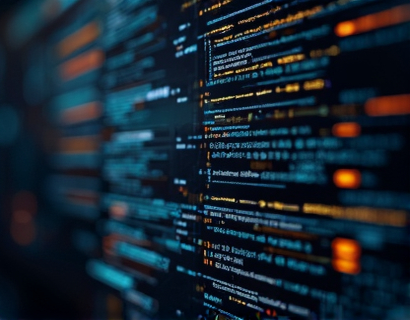Harnessing AI and Crypto: Revolutionizing Ucosystem Applications for the Next Generation
The convergence of artificial intelligence (AI) and cryptocurrency is reshaping the landscape of technology, creating a new paradigm for digital interactions and applications. As we delve into this revolutionary impact, it becomes evident that the integration of these two powerful forces is not just a trend but a fundamental shift that is transforming how we engage with technology. This article explores the implications of merging AI and cryptocurrency, focusing on the next generation of tech-driven applications that are set to redefine user experiences in the digital realm.
The Rise of Cryptocurrency and AI
Cryptocurrency has emerged as a disruptive force in the financial sector, offering decentralized alternatives to traditional banking systems. Bitcoin, Ethereum, and countless altcoins have paved the way for a new era of digital currency, characterized by transparency, security, and accessibility. On the other hand, AI has made significant strides in various fields, from healthcare to finance, enhancing decision-making processes and automating tasks that were once labor-intensive.
The intersection of these two technologies presents unique opportunities for innovation. By leveraging the decentralized nature of cryptocurrencies alongside the analytical capabilities of AI, developers can create applications that not only streamline processes but also enhance user engagement and satisfaction.
Transforming Digital Interactions
One of the most significant impacts of combining AI and cryptocurrency is the transformation of digital interactions. Traditional online platforms often rely on centralized systems that can be vulnerable to data breaches and manipulation. In contrast, blockchain technology, which underpins most cryptocurrencies, offers a secure and transparent framework for transactions and data storage.
AI can enhance this framework by providing intelligent insights and predictive analytics. For instance, AI algorithms can analyze user behavior on decentralized platforms, allowing for personalized experiences that cater to individual preferences. This level of customization not only improves user satisfaction but also fosters loyalty, as users feel more connected to the platforms they engage with.
Next-Generation Applications in the Ucosystem
The Ucosystem, a term that encapsulates the ecosystem of applications powered by AI and cryptocurrency, is witnessing the emergence of next-generation applications that are set to revolutionize various sectors. Here are some key areas where this integration is making a significant impact:
1. Decentralized Finance (DeFi)
Decentralized finance is one of the most prominent applications of cryptocurrency, allowing users to engage in financial transactions without intermediaries. AI plays a crucial role in enhancing DeFi platforms by providing risk assessment tools, automated trading strategies, and personalized financial advice. By analyzing market trends and user data, AI can help users make informed decisions, maximizing their returns while minimizing risks.
2. Smart Contracts
Smart contracts are self-executing contracts with the terms of the agreement directly written into code. The integration of AI can enhance the functionality of smart contracts by enabling them to adapt to changing conditions. For example, an AI-powered smart contract could automatically adjust terms based on real-time data, ensuring that all parties involved are treated fairly and transparently.
3. Supply Chain Management
The combination of AI and cryptocurrency can significantly improve supply chain management by providing real-time tracking and verification of goods. Blockchain technology ensures that all transactions are recorded securely, while AI can analyze data to predict potential disruptions and optimize logistics. This level of transparency and efficiency can lead to reduced costs and improved customer satisfaction.
4. Identity Verification
Identity verification is a critical aspect of online interactions, particularly in financial transactions. The integration of AI and cryptocurrency can streamline this process by providing secure and efficient methods for verifying identities. AI algorithms can analyze biometric data, while blockchain technology can securely store and manage identity information, reducing the risk of fraud and enhancing user trust.
5. Content Creation and Distribution
The creative industry is also benefiting from the merger of AI and cryptocurrency. AI-powered tools can assist in content creation, from generating articles to producing music and art. Additionally, blockchain technology can facilitate fair compensation for creators by ensuring that their work is securely tracked and monetized. This not only empowers artists but also fosters a more equitable distribution of wealth within the creative sector.
Challenges and Considerations
While the potential of merging AI and cryptocurrency is immense, it is essential to acknowledge the challenges that come with it. Regulatory concerns, security risks, and ethical considerations are just a few of the hurdles that developers and users must navigate. As the technology continues to evolve, it is crucial to establish frameworks that promote responsible innovation while safeguarding user interests.
Regulatory Landscape
The regulatory landscape surrounding cryptocurrency is still developing, with governments around the world grappling with how to approach this new technology. As AI becomes more integrated into cryptocurrency applications, regulators will need to consider the implications of automated decision-making and data privacy. Striking a balance between innovation and regulation will be key to fostering a healthy ecosystem.
Security Risks
Security remains a top concern in the cryptocurrency space, with numerous high-profile hacks and scams making headlines. The integration of AI can both mitigate and exacerbate these risks. While AI can enhance security measures through predictive analytics and anomaly detection, it can also be exploited by malicious actors to develop sophisticated attacks. Ensuring robust security protocols will be essential for the success of AI-powered cryptocurrency applications.
Ethical Considerations
The ethical implications of AI in cryptocurrency applications cannot be overlooked. Issues such as bias in AI algorithms, data privacy, and the potential for job displacement must be addressed as the technology continues to evolve. Developers and stakeholders must prioritize ethical considerations to build trust and ensure that the benefits of these innovations are accessible to all.
The Future of AI and Cryptocurrency
As we look to the future, the potential for AI and cryptocurrency to reshape the digital landscape is vast. The next generation of applications will likely focus on enhancing user experiences, improving security, and fostering greater transparency. By harnessing the power of these technologies, developers can create solutions that not only meet the needs of users but also contribute to a more equitable and sustainable digital ecosystem.
1. Enhanced User Experiences
The future of technology lies in creating seamless and intuitive user experiences. AI can play a pivotal role in achieving this by providing personalized recommendations, automating processes, and enhancing user interfaces. As cryptocurrency becomes more mainstream, the integration of AI will be crucial in ensuring that users can navigate these platforms with ease.
2. Improved Security Measures
Security will remain a top priority as the cryptocurrency landscape evolves. The integration of AI can enhance security measures by providing real-time monitoring, anomaly detection, and predictive analytics. By leveraging AI, developers can create more robust security protocols that protect users from potential threats.
3. Greater Transparency
Transparency is a fundamental principle of both AI and cryptocurrency. As these technologies continue to converge, we can expect to see greater transparency in transactions, data management, and decision-making processes. This level of transparency will foster trust among users and encourage wider adoption of these technologies.
Conclusion
The merging of AI and cryptocurrency is revolutionizing the way we interact with technology, creating a new era of applications that are set to transform various sectors. From decentralized finance to content creation, the potential for innovation is immense. However, as we embrace these advancements, it is essential to navigate the challenges and ethical considerations that come with them. By prioritizing responsible innovation and user-centric design, we can harness the power of AI and cryptocurrency to create a more equitable and sustainable digital ecosystem for the next generation.











































